EXHIBIT 99.2
Published on April 15, 2020
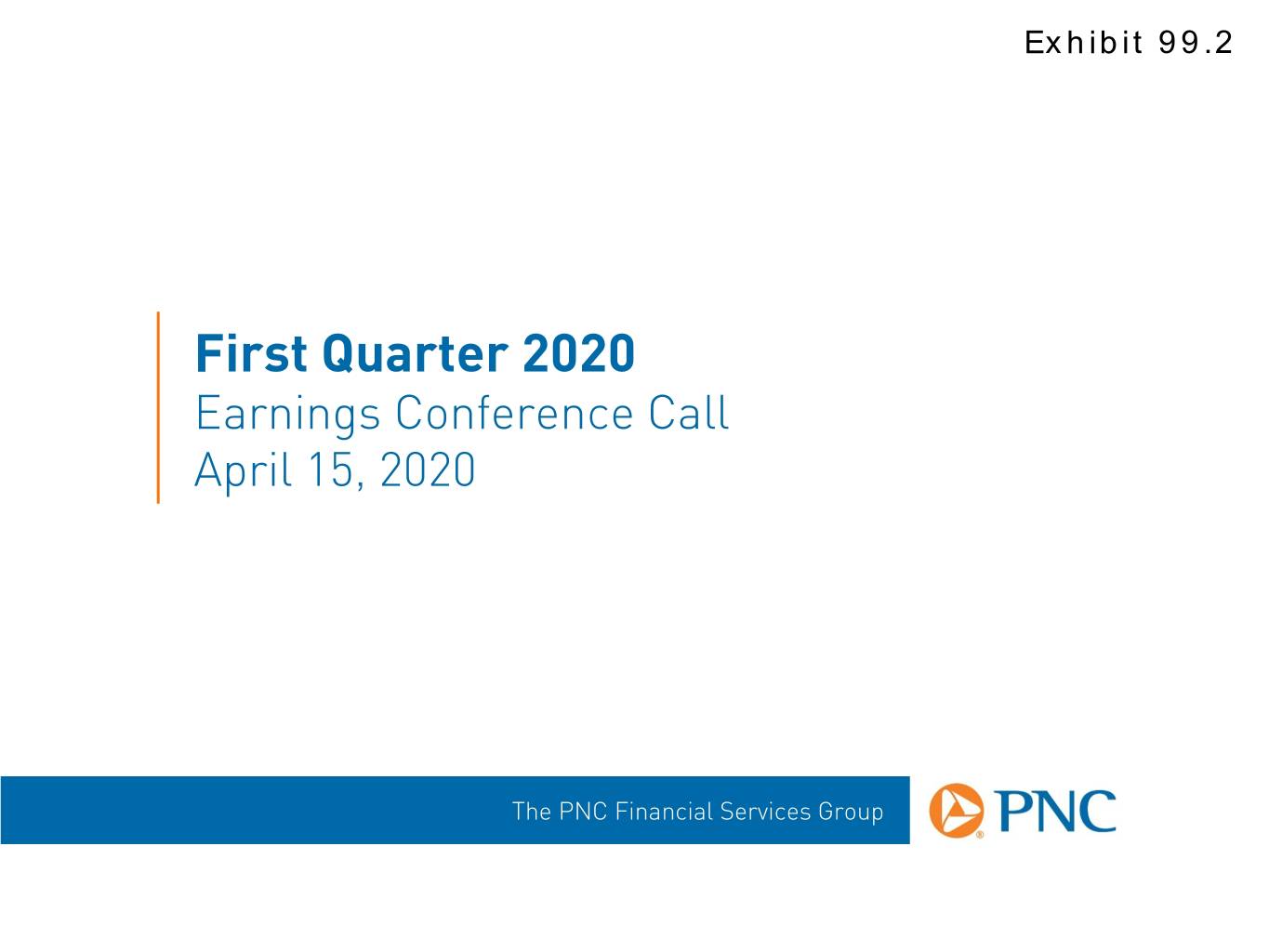
Exhibit 99.2 First Quarter 2020 Earnings Conference Call April 15, 2020 The PNC Financial Services Group

Cautionary Statement Regarding Forward-Looking and Non-GAAP Financial Information Our earnings conference call presentation is not intended as a full business or financial review and should be viewed in the context of all of the information made available by PNC in its SEC filings and on our corporate website. The presentation contains forward-looking statements regarding our outlook for earnings, revenues, expenses, tax rates, capital and liquidity levels and ratios, asset levels, asset quality, financial position, and other matters regarding or affecting PNC and its future business and operations. Forward-looking statements are necessarily subject to numerous assumptions, risks and uncertainties, which change over time. The forward-looking statements in this presentation are qualified by the factors affecting forward-looking statements identified in the more detailed Cautionary Statement included in the Appendix. We provide greater detail regarding these as well as other factors in our 2019 Form 10-K and in our subsequent SEC filings. In particular, our forward-looking statements are subject to risks and uncertainties related to the COVID-19 pandemic and the resulting governmental and societal responses. Our forward-looking statements may also be subject to risks and uncertainties including those we may discuss in this presentation or in our SEC filings. Future events or circumstances may change our outlook and may also affect the nature of the assumptions, risks and uncertainties to which our forward-looking statements are subject. Forward-looking statements in this presentation speak only as of the date of this presentation. We do not assume any duty and do not undertake to update those statements. Actual results or future events could differ, possibly materially, from those anticipated in forward- looking statements, as well as from historical performance. As a result, we caution against placing undue reliance on any forward-looking statements. We include non-GAAP financial information in this presentation. Non-GAAP financial information includes financial metrics such as fee income, tangible book value, pretax, pre-provision earnings and return on tangible common equity. Reconciliations for such financial information may be found in our presentation, in these slides, including the Appendix, in other materials on our corporate website, and in our SEC filings. This information supplements our results as reported in accordance with GAAP and should not be viewed in isolation from, or as a substitute for, our GAAP results. We believe that this information and the related reconciliations may be useful to investors, analysts, regulators and others to help understand and evaluate our financial results, and with respect to adjusted metrics, because we believe they better reflect the ongoing financial results and trends of our businesses and increase comparability of period-to- period results. We may also use annualized, pro forma, estimated or third party numbers for illustrative or comparative purposes only. These may not reflect actual results. References to our corporate website are to www.pnc.com under “About Us - Investor Relations.” Our SEC filings are available both on our corporate website and on the SEC’s website at www.sec.gov. We include web addresses here as inactive textual references only. Information on these websites is not part of this presentation. 2
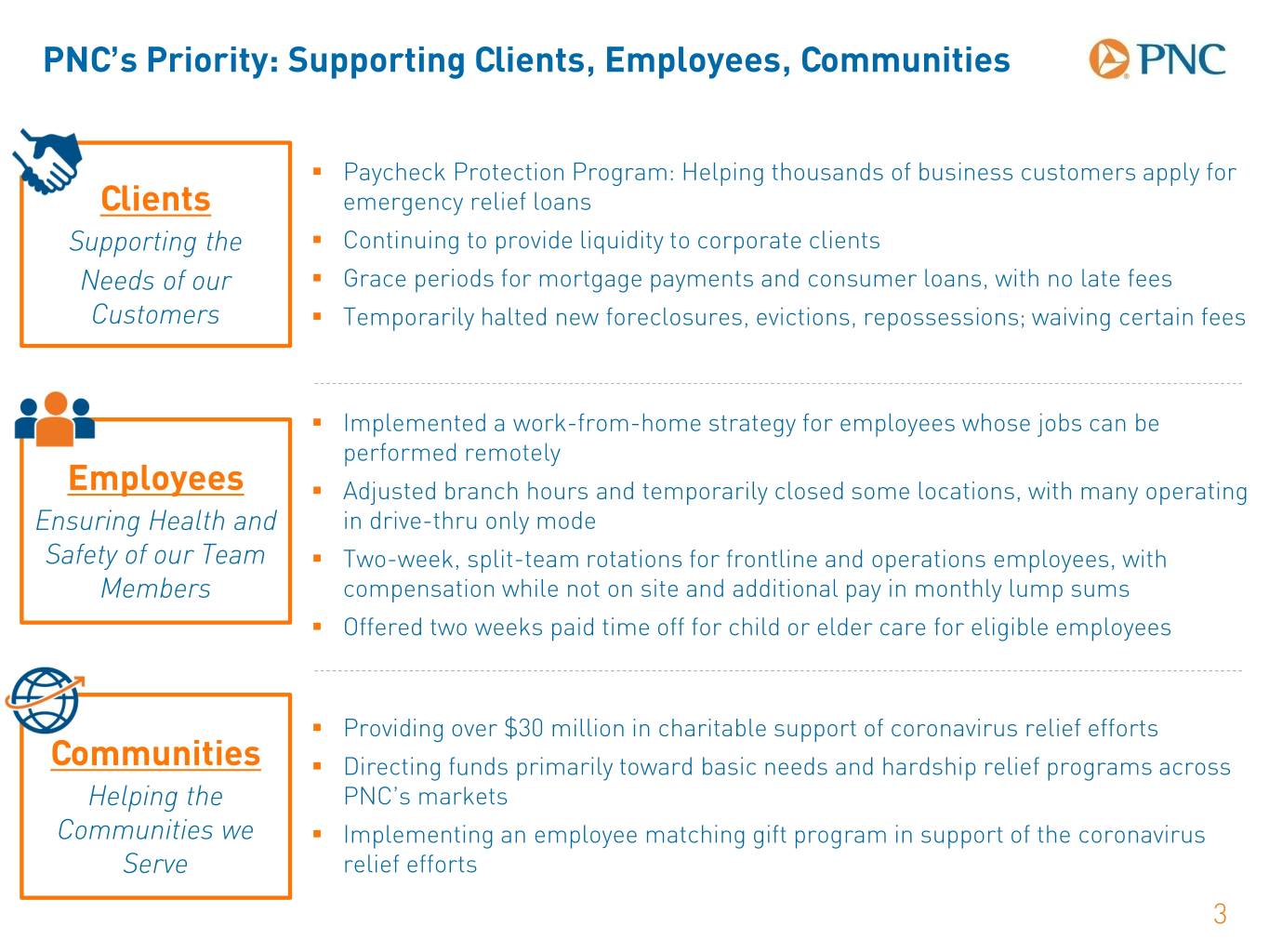
PNC’s Priority: Supporting Clients, Employees, Communities . Paycheck Protection Program: Helping thousands of business customers apply for Clients emergency relief loans Supporting the . Continuing to provide liquidity to corporate clients Needs of our . Grace periods for mortgage payments and consumer loans, with no late fees Customers . Temporarily halted new foreclosures, evictions, repossessions; waiving certain fees . Implemented a work-from-home strategy for employees whose jobs can be performed remotely Employees . Adjusted branch hours and temporarily closed some locations, with many operating Ensuring Health and in drive-thru only mode Safety of our Team . Two-week, split-team rotations for frontline and operations employees, with Members compensation while not on site and additional pay in monthly lump sums . Offered two weeks paid time off for child or elder care for eligible employees . Providing over $30 million in charitable support of coronavirus relief efforts Communities . Directing funds primarily toward basic needs and hardship relief programs across Helping the PNC’s markets Communities we . Implementing an employee matching gift program in support of the coronavirus Serve relief efforts 3
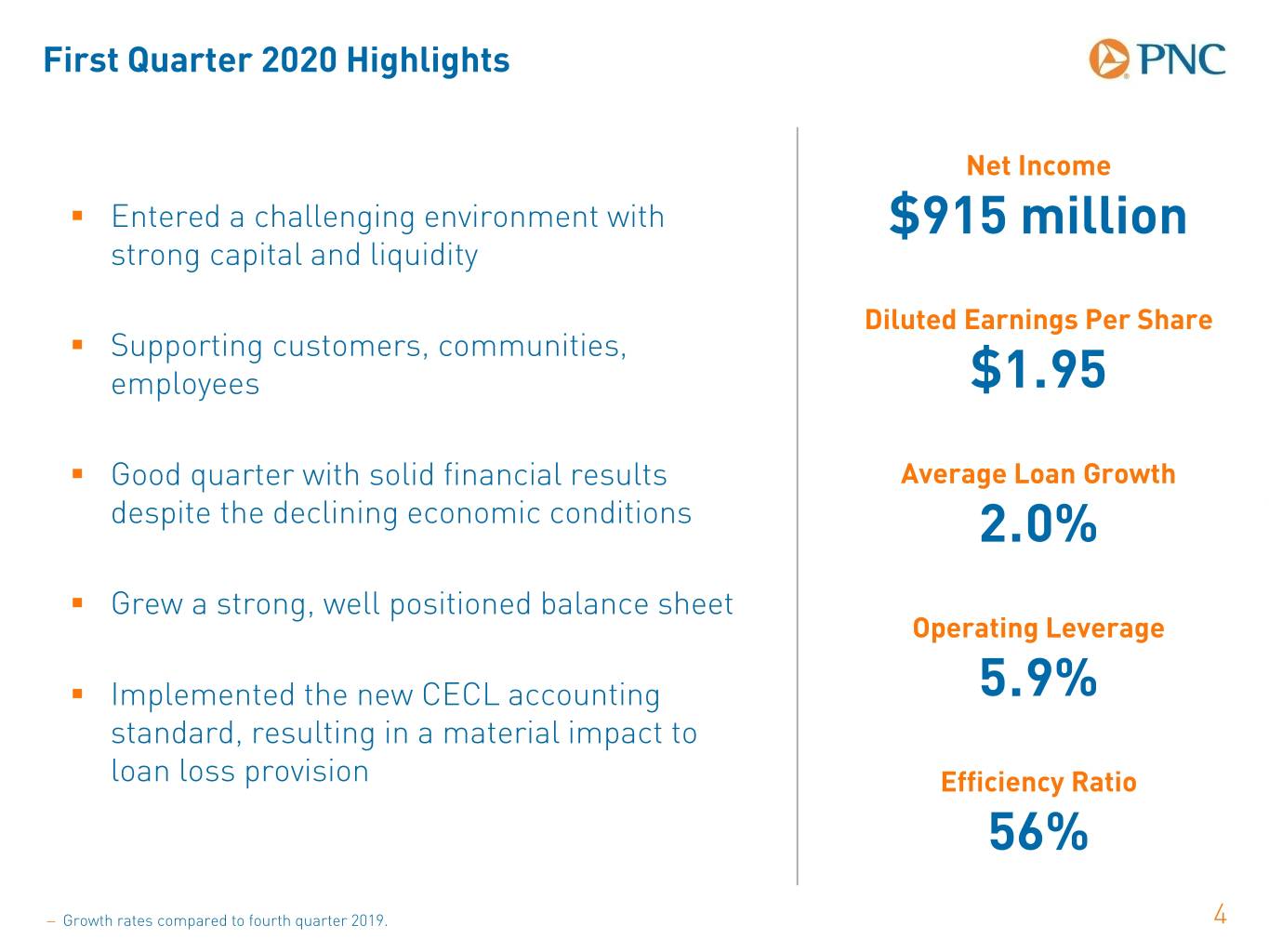
First Quarter 2020 Highlights Net Income . Entered a challenging environment with $915 million strong capital and liquidity Diluted Earnings Per Share . Supporting customers, communities, employees $1.95 . Good quarter with solid financial results Average Loan Growth despite the declining economic conditions 2.0% . Grew a strong, well positioned balance sheet Operating Leverage . Implemented the new CECL accounting 5.9% standard, resulting in a material impact to loan loss provision Efficiency Ratio 56% − Growth rates compared to fourth quarter 2019. 4
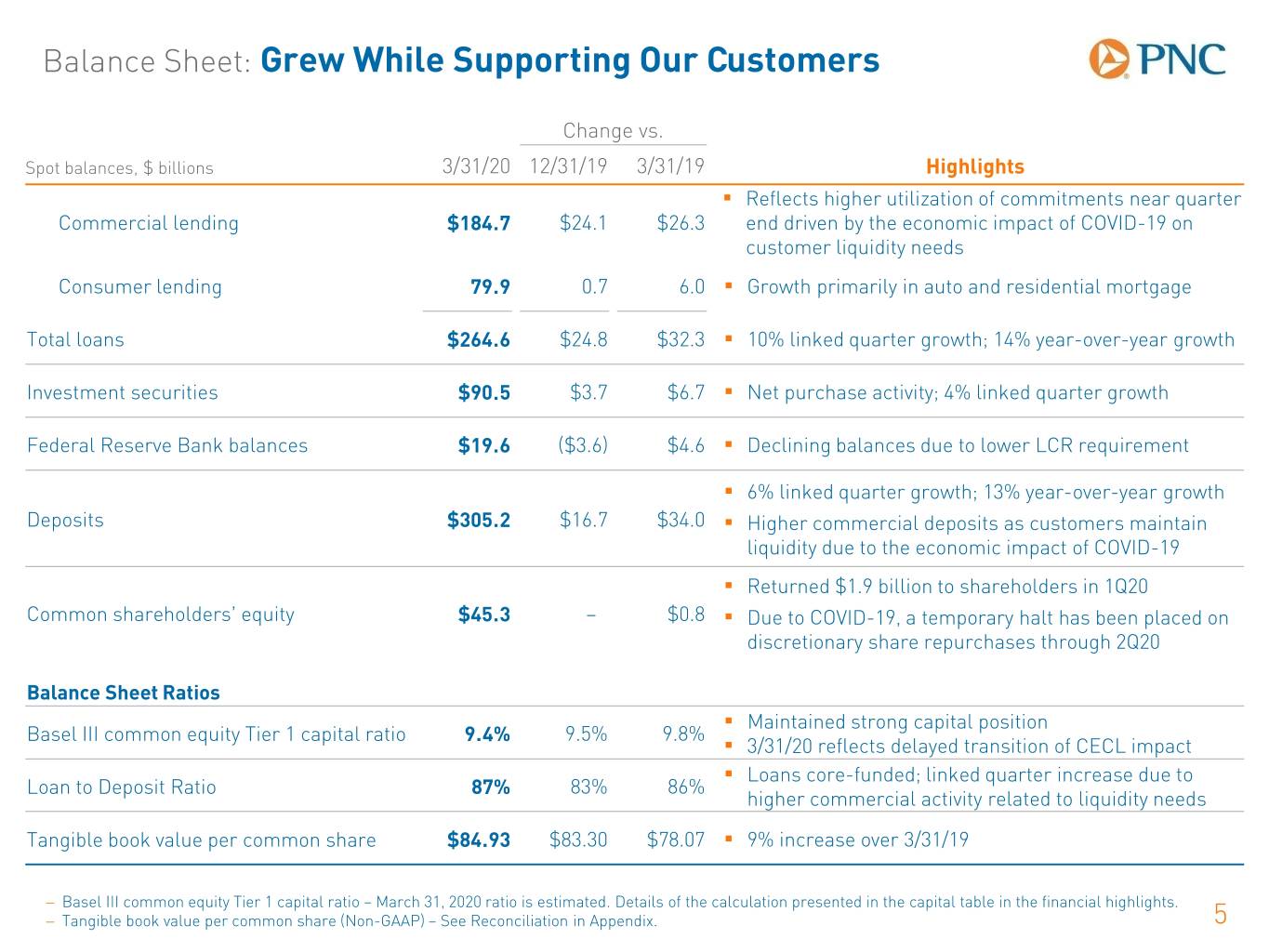
Balance Sheet: Grew While Supporting Our Customers Change vs. Spot balances, $ billions 3/31/20 12/31/19 3/31/19 Highlights . Reflects higher utilization of commitments near quarter Commercial lending $184.7 $24.1 $26.3 end driven by the economic impact of COVID-19 on customer liquidity needs Consumer lending 79.9 0.7 6.0 . Growth primarily in auto and residential mortgage Total loans $264.6 $24.8 $32.3 . 10% linked quarter growth; 14% year-over-year growth Investment securities $90.5 $3.7 $6.7 . Net purchase activity; 4% linked quarter growth Federal Reserve Bank balances $19.6 ($3.6) $4.6 . Declining balances due to lower LCR requirement . 6% linked quarter growth; 13% year-over-year growth Deposits $305.2 $16.7 $34.0 . Higher commercial deposits as customers maintain liquidity due to the economic impact of COVID-19 . Returned $1.9 billion to shareholders in 1Q20 Common shareholders’ equity $45.3 – $0.8 . Due to COVID-19, a temporary halt has been placed on discretionary share repurchases through 2Q20 Balance Sheet Ratios . Maintained strong capital position Basel III common equity Tier 1 capital ratio 9.4% 9.5% 9.8% . 3/31/20 reflects delayed transition of CECL impact . Loans core-funded; linked quarter increase due to Loan to Deposit Ratio 87% 83% 86% higher commercial activity related to liquidity needs Tangible book value per common share $84.93 $83.30 $78.07 . 9% increase over 3/31/19 − Basel III common equity Tier 1 capital ratio – March 31, 2020 ratio is estimated. Details of the calculation presented in the capital table in the financial highlights. − Tangible book value per common share (Non-GAAP) – See Reconciliation in Appendix. 5
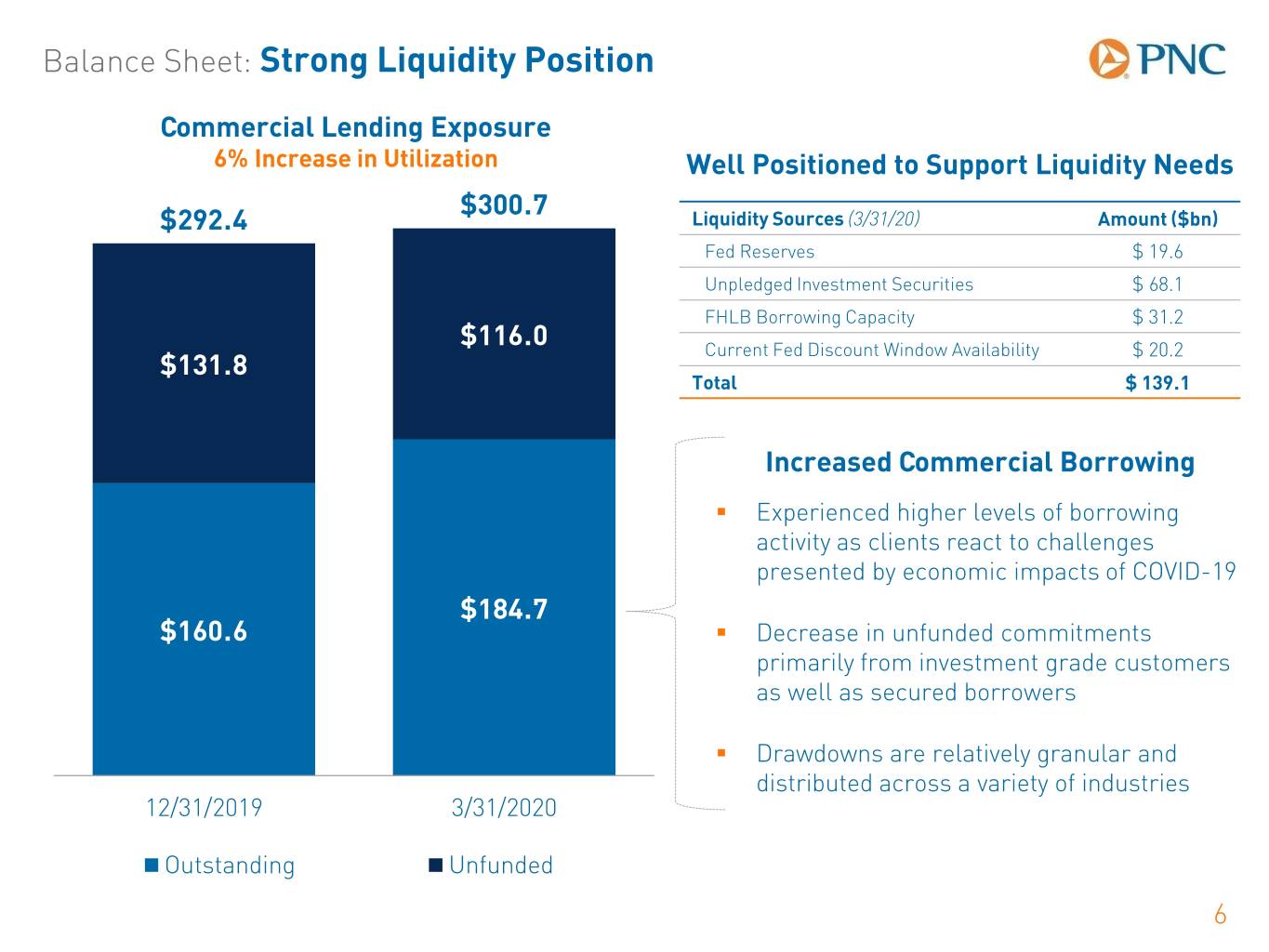
Balance Sheet: Strong Liquidity Position Commercial Lending Exposure 6% Increase in Utilization Well Positioned to Support Liquidity Needs $300.7 $292.4 Liquidity Sources (3/31/20) Amount ($bn) Fed Reserves $ 19.6 Unpledged Investment Securities $ 68.1 FHLB Borrowing Capacity $ 31.2 $116.0 Current Fed Discount Window Availability $ 20.2 $131.8 Total $ 139.1 Increased Commercial Borrowing . Experienced higher levels of borrowing activity as clients react to challenges presented by economic impacts of COVID-19 $184.7 $160.6 . Decrease in unfunded commitments primarily from investment grade customers as well as secured borrowers . Drawdowns are relatively granular and distributed across a variety of industries 12/31/2019 3/31/2020 Outstanding Unfunded 6
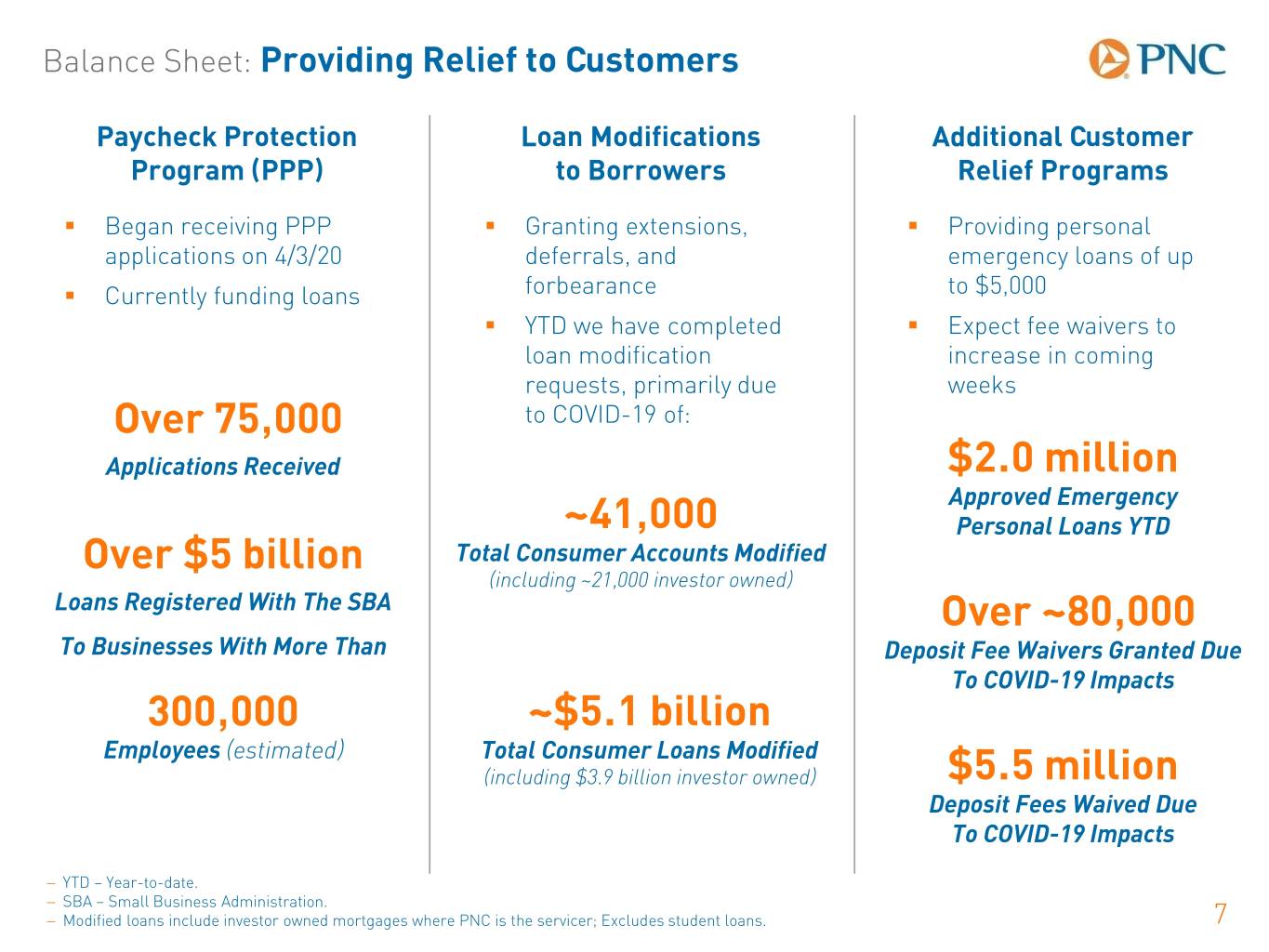
Balance Sheet: Providing Relief to Customers Paycheck Protection Loan Modifications Additional Customer Program (PPP) to Borrowers Relief Programs . Began receiving PPP . Granting extensions, . Providing personal applications on 4/3/20 deferrals, and emergency loans of up . Currently funding loans forbearance to $5,000 . YTD we have completed . Expect fee waivers to loan modification increase in coming requests, primarily due weeks Over 75,000 to COVID-19 of: Applications Received $2.0 million Approved Emergency ~41,000 Personal Loans YTD Over $5 billion Total Consumer Accounts Modified (including ~21,000 investor owned) Loans Registered With The SBA Over ~80,000 To Businesses With More Than Deposit Fee Waivers Granted Due To COVID-19 Impacts 300,000 ~$5.1 billion Employees (estimated) Total Consumer Loans Modified (including $3.9 billion investor owned) $5.5 million Deposit Fees Waived Due To COVID-19 Impacts − YTD – Year-to-date. − SBA – Small Business Administration. − Modified loans include investor owned mortgages where PNC is the servicer; Excludes student loans. 7
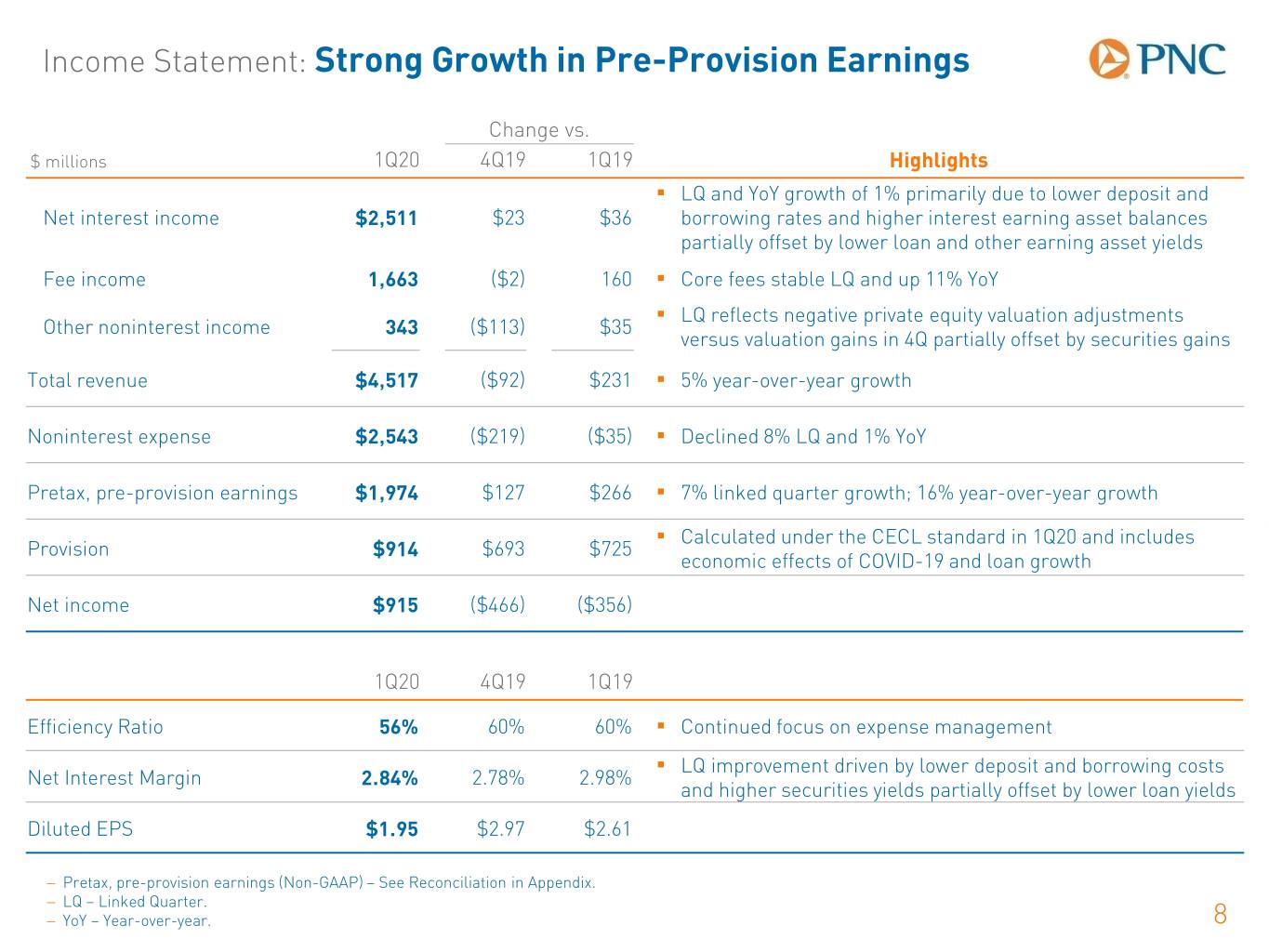
Income Statement: Strong Growth in Pre-Provision Earnings Change vs. $ millions 1Q20 4Q19 1Q19 Highlights . LQ and YoY growth of 1% primarily due to lower deposit and Net interest income $2,511 $23 $36 borrowing rates and higher interest earning asset balances partially offset by lower loan and other earning asset yields Fee income 1,663 ($2) 160 . Core fees stable LQ and up 11% YoY . LQ reflects negative private equity valuation adjustments Other noninterest income 343 ($113) $35 versus valuation gains in 4Q partially offset by securities gains Total revenue $4,517 ($92) $231 . 5% year-over-year growth Noninterest expense $2,543 ($219) ($35) . Declined 8% LQ and 1% YoY Pretax, pre-provision earnings $1,974 $127 $266 . 7% linked quarter growth; 16% year-over-year growth . Calculated under the CECL standard in 1Q20 and includes Provision $914 $693 $725 economic effects of COVID-19 and loan growth Net income $915 ($466) ($356) 1Q20 4Q19 1Q19 Efficiency Ratio 56% 60% 60% . Continued focus on expense management . LQ improvement driven by lower deposit and borrowing costs Net Interest Margin 2.84% 2.78% 2.98% and higher securities yields partially offset by lower loan yields Diluted EPS $1.95 $2.97 $2.61 − Pretax, pre-provision earnings (Non-GAAP) – See Reconciliation in Appendix. − LQ – Linked Quarter. − YoY – Year-over-year. 8

Credit Quality: COVID-19 High Impact Industries $19.3 billion Outstanding Loan Balances $10.6 billion Commercial & Equipment Lease Financing Loans $4.4 billion / 1.6% of Loans Leisure Recreation: Restaurants, casinos, hotels, convention centers 73% Utilization $2.5 billion / 0.9% of Loans Retail (non-essential): Retail excluding auto, gas, staples 61% Utilization and 59% ABL $1.6 billion / 0.6% of Loans Healthcare Facilities: Elective, private practices 84% Utilization $0.8 billion / 0.3% of Loans Leisure Travel: Cruise, airlines, other travel / transportation 82% Utilization $0.6 billion / 0.2% of Loans Consumer Services: Religious organizations, childcare 75% Utilization $0.8 billion / 0.3% of Loans Other Impacted Areas: Shipping, delayed demand, specialty education 47% Utilization and 12% ABL $8.7 billion Commercial Real Estate and Related Loans $3.8 billion / 1.4% of Loans Non-Essential Retail & Restaurants: Malls, lifestyle centers, outlets, restaurants 81% Utilization $3.2 billion / 1.2% of Loans Hotel: Full service, limited service, extended stay 90% Utilization $1.7 billion / 0.6% of Loans Seniors Housing: Assisted living, independent living 61% Utilization − Balances as of 3/31/20; excludes securitizations. − ABL - Asset Based Lending. Shown in areas where material. − Commercial & equipment lease financing loans exclude PNC Real Estate business loans. Commercial real estate and related loans include commercial 9 loans in the PNC Real Estate business.
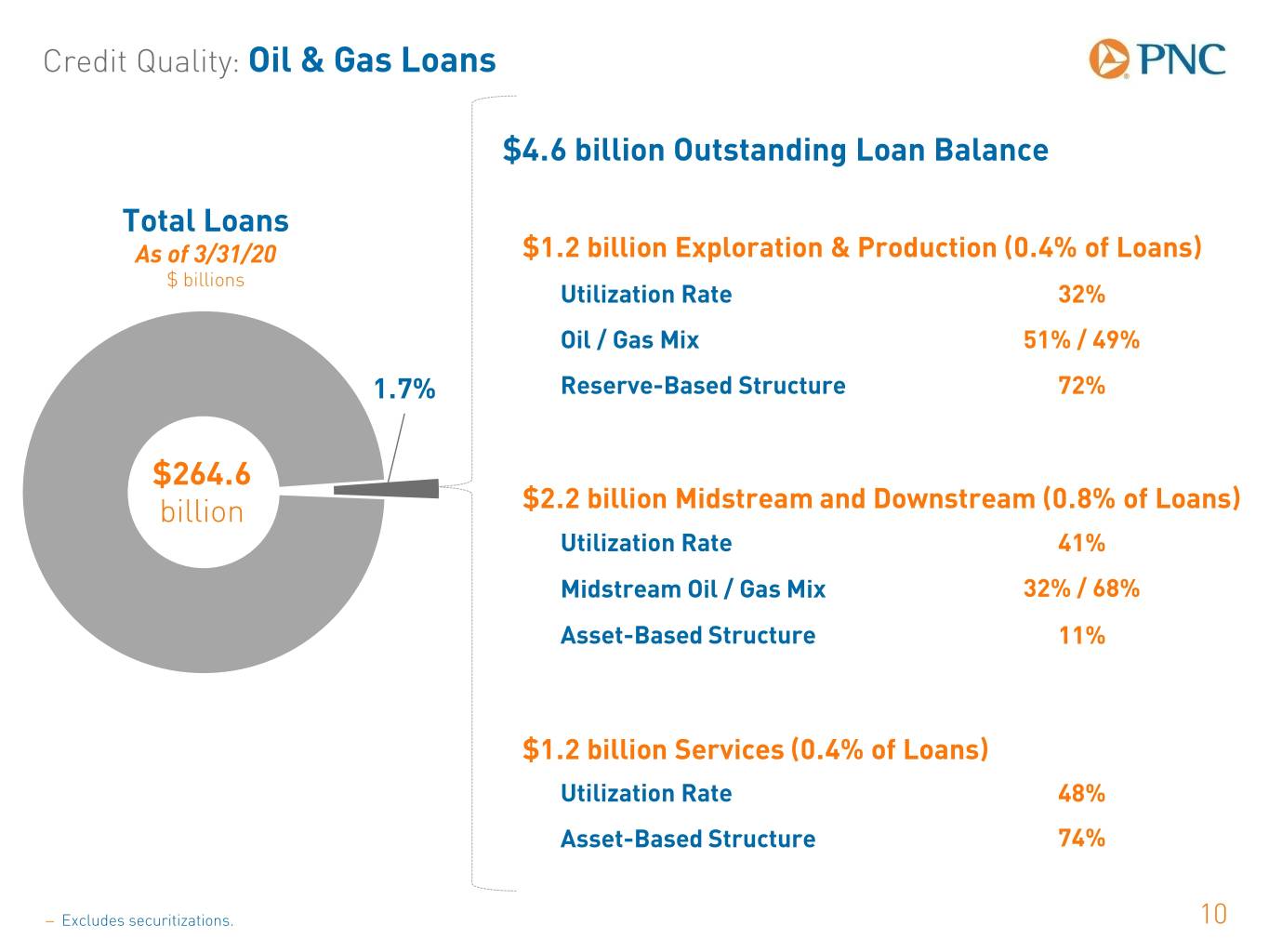
Credit Quality: Oil & Gas Loans $4.6 billion Outstanding Loan Balance Total Loans As of 3/31/20 $1.2 billion Exploration & Production (0.4% of Loans) $ billions Utilization Rate 32% Oil / Gas Mix 51% / 49% 1.7% Reserve-Based Structure 72% $264.6 billion $2.2 billion Midstream and Downstream (0.8% of Loans) Utilization Rate 41% Midstream Oil / Gas Mix 32% / 68% Asset-Based Structure 11% $1.2 billion Services (0.4% of Loans) Utilization Rate 48% Asset-Based Structure 74% − Excludes securitizations. 10
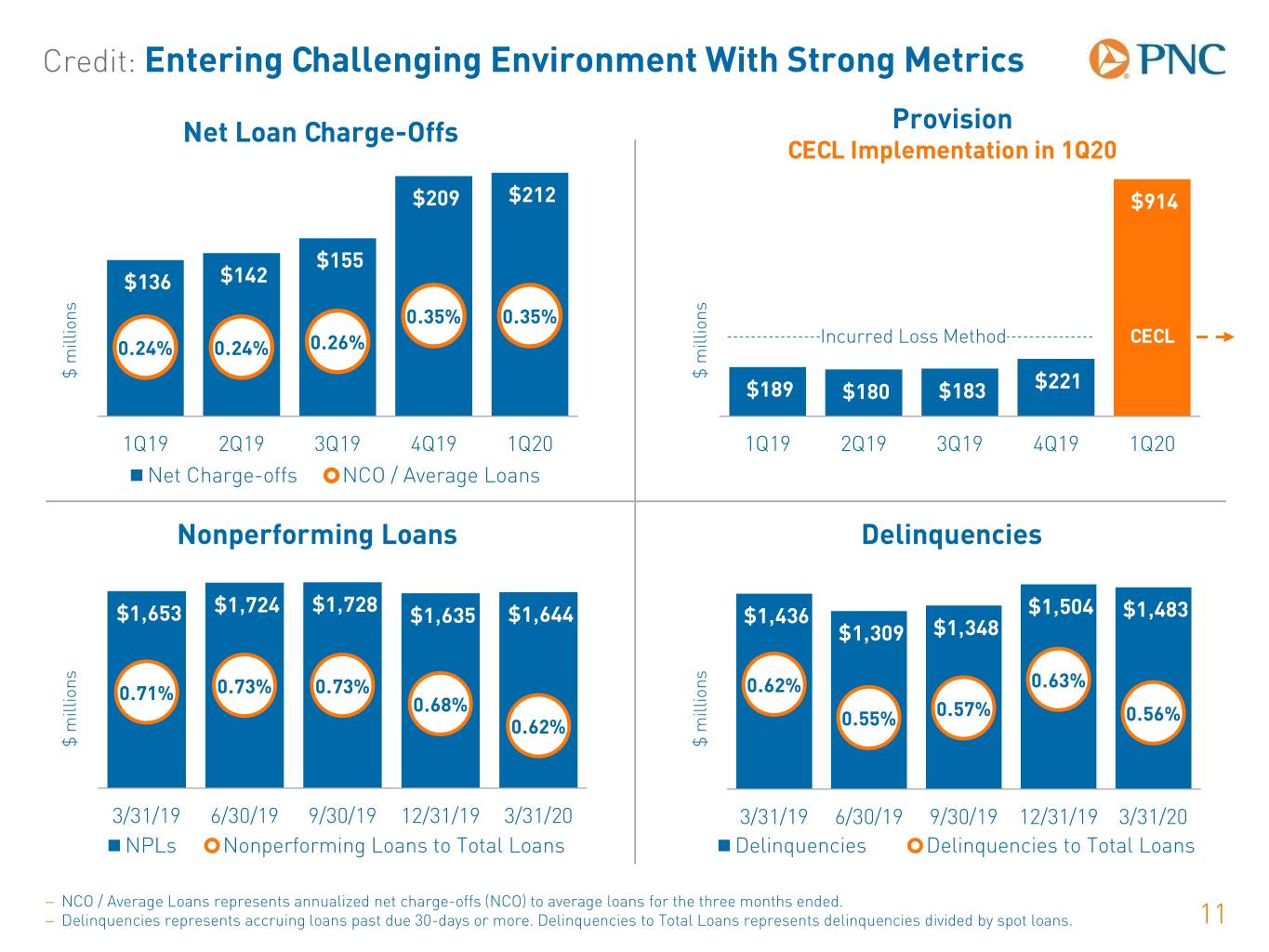
Credit: Entering Challenging Environment With Strong Metrics Net Loan Charge-Offs 1.00% Provision CECL Implementation in 1Q20 0.80% $209 $212 $914 0.60% $155 $136 $142 0.40% 0.35% 0.35% 0.26% Incurred Loss Method CECL 0.24% 0.24% 0.20% $ millions $ millions $221 $189 $180 $183 0.00% 1Q19 2Q19 3Q19 4Q19 1Q20 1Q19 2Q19 3Q19 4Q19 1Q20 Net Charge-offs NCO / Average Loans Nonperforming Loans Delinquencies 0.90% $1,600 $1,400 0.80% $1,653 $1,724 $1,728 $1,504 $1,483 $1,635 $1,644 $1,200 $1,436 $1,309 $1,348 0.70% $1,000 $800 0.63% 0.71% 0.73% 0.73% 0.62% 0.60% 0.68% $600 0.55% 0.57% 0.56% 0.62% $400 0.50% $ millions $ millions $200 $- 0.40% 3/31/19 6/30/19 9/30/19 12/31/19 3/31/20 3/31/19 6/30/19 9/30/19 12/31/19 3/31/20 NPLs Nonperforming Loans to Total Loans Delinquencies Delinquencies to Total Loans − NCO / Average Loans represents annualized net charge-offs (NCO) to average loans for the three months ended. − Delinquencies represents accruing loans past due 30-days or more. Delinquencies to Total Loans represents delinquencies divided by spot loans. 11

Credit: Drivers of Change Under CECL Allowance for Credit Losses – Loans and Leases and Off-Balance Sheet Credit Exposures Economic Factors Portfolio $496 Day 1 Changes Adjustment $196 . Changes to macro- . New loans economic $642 . Changes in variables credit quality . Changes to . Aging of weightings . CECL Day 1 $4,394 existing assigned to the transition portfolio four scenarios adjustment . Charge-offs . Includes ACL and recoveries $3,060 for loans and leases and off-balance sheet credit exposures 1 2 3 4 5 ALLL ACL 12/31/19 3/31/20 − Figures in millions. − ALLL at 12/31/19 includes allowance for loans and leases and off-balance sheet credit exposures. − CECL Day 1 Adjustment excludes a $19 million transition adjustment for Other assets, and Portfolio Changes excludes $9 million of provision for Other assets. 12
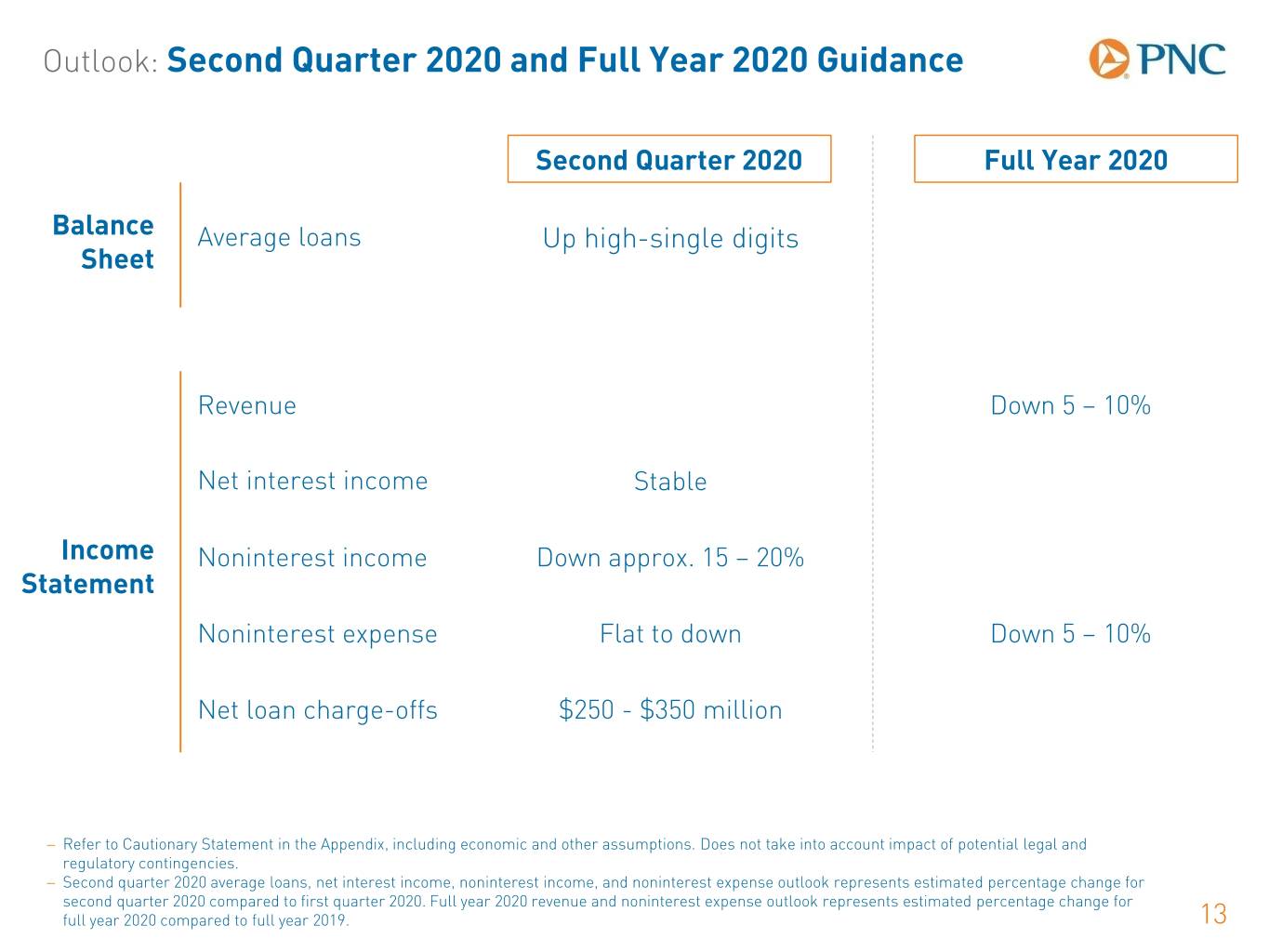
Outlook: Second Quarter 2020 and Full Year 2020 Guidance Second Quarter 2020 Full Year 2020 Balance Average loans Up high-single digits Sheet Revenue Down 5 – 10% Net interest income Stable Income Noninterest income Down approx. 15 – 20% Statement Noninterest expense Flat to down Down 5 – 10% Net loan charge-offs $250 - $350 million − Refer to Cautionary Statement in the Appendix, including economic and other assumptions. Does not take into account impact of potential legal and regulatory contingencies. − Second quarter 2020 average loans, net interest income, noninterest income, and noninterest expense outlook represents estimated percentage change for second quarter 2020 compared to first quarter 2020. Full year 2020 revenue and noninterest expense outlook represents estimated percentage change for full year 2020 compared to full year 2019. 13
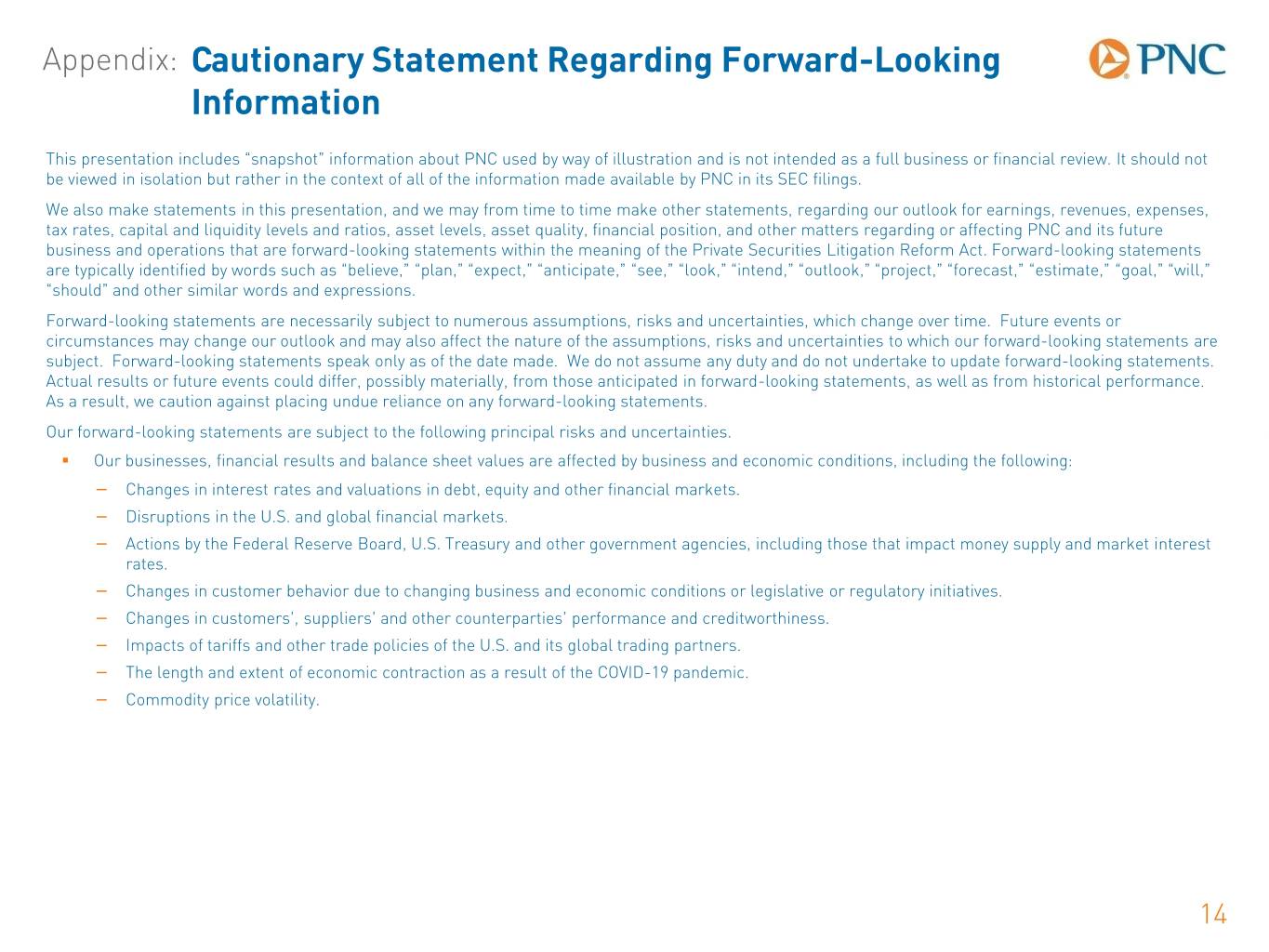
Appendix: Cautionary Statement Regarding Forward-Looking Information This presentation includes “snapshot” information about PNC used by way of illustration and is not intended as a full business or financial review. It should not be viewed in isolation but rather in the context of all of the information made available by PNC in its SEC filings. We also make statements in this presentation, and we may from time to time make other statements, regarding our outlook for earnings, revenues, expenses, tax rates, capital and liquidity levels and ratios, asset levels, asset quality, financial position, and other matters regarding or affecting PNC and its future business and operations that are forward-looking statements within the meaning of the Private Securities Litigation Reform Act. Forward-looking statements are typically identified by words such as “believe,” “plan,” “expect,” “anticipate,” “see,” “look,” “intend,” “outlook,” “project,” “forecast,” “estimate,” “goal,” “will,” “should” and other similar words and expressions. Forward-looking statements are necessarily subject to numerous assumptions, risks and uncertainties, which change over time. Future events or circumstances may change our outlook and may also affect the nature of the assumptions, risks and uncertainties to which our forward-looking statements are subject. Forward-looking statements speak only as of the date made. We do not assume any duty and do not undertake to update forward-looking statements. Actual results or future events could differ, possibly materially, from those anticipated in forward-looking statements, as well as from historical performance. As a result, we caution against placing undue reliance on any forward-looking statements. Our forward-looking statements are subject to the following principal risks and uncertainties. . Our businesses, financial results and balance sheet values are affected by business and economic conditions, including the following: − Changes in interest rates and valuations in debt, equity and other financial markets. − Disruptions in the U.S. and global financial markets. − Actions by the Federal Reserve Board, U.S. Treasury and other government agencies, including those that impact money supply and market interest rates. − Changes in customer behavior due to changing business and economic conditions or legislative or regulatory initiatives. − Changes in customers’, suppliers’ and other counterparties’ performance and creditworthiness. − Impacts of tariffs and other trade policies of the U.S. and its global trading partners. − The length and extent of economic contraction as a result of the COVID-19 pandemic. − Commodity price volatility. 14
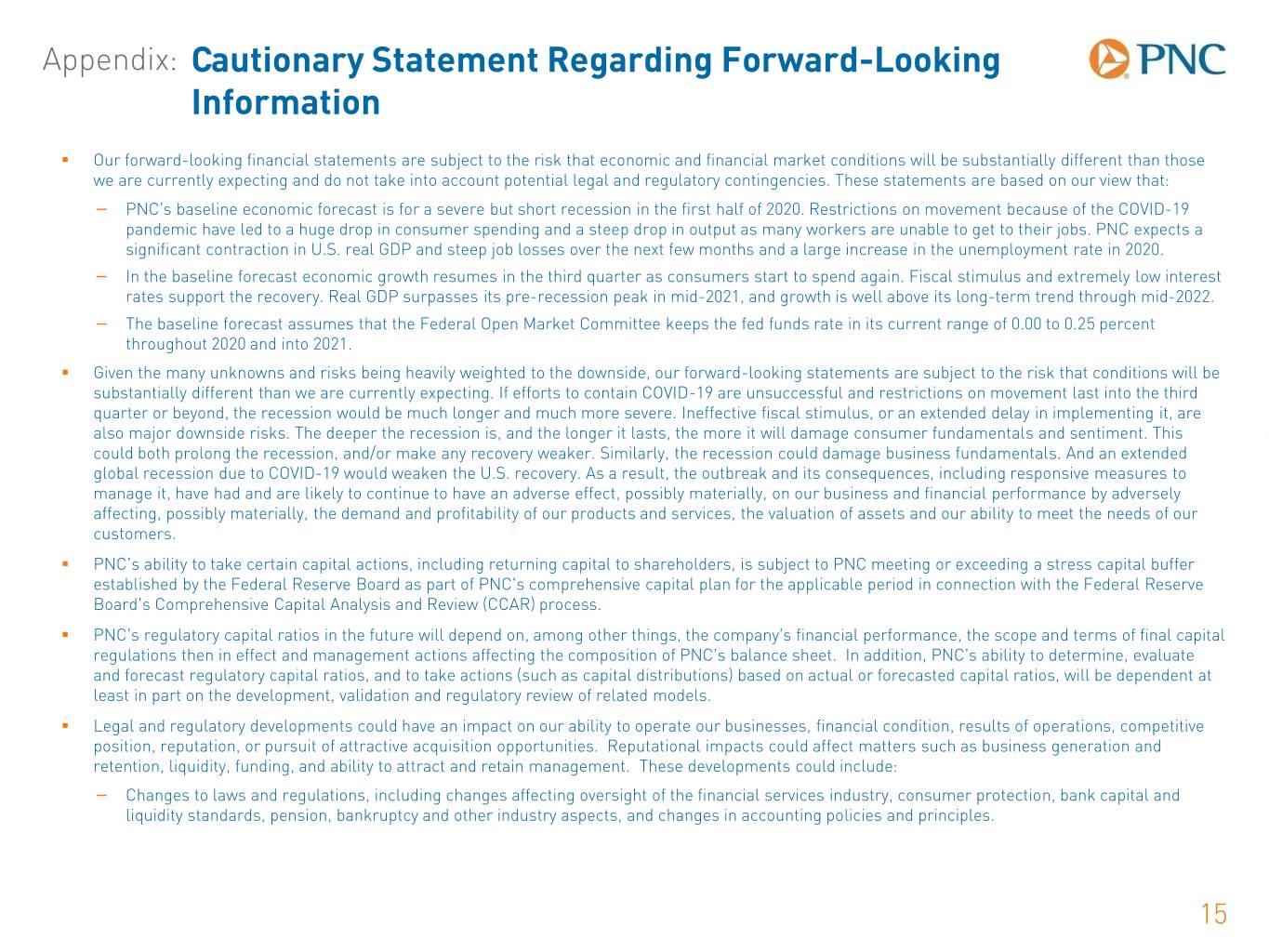
Appendix: Cautionary Statement Regarding Forward-Looking Information . Our forward-looking financial statements are subject to the risk that economic and financial market conditions will be substantially different than those we are currently expecting and do not take into account potential legal and regulatory contingencies. These statements are based on our view that: − PNC’s baseline economic forecast is for a severe but short recession in the first half of 2020. Restrictions on movement because of the COVID-19 pandemic have led to a huge drop in consumer spending and a steep drop in output as many workers are unable to get to their jobs. PNC expects a significant contraction in U.S. real GDP and steep job losses over the next few months and a large increase in the unemployment rate in 2020. − In the baseline forecast economic growth resumes in the third quarter as consumers start to spend again. Fiscal stimulus and extremely low interest rates support the recovery. Real GDP surpasses its pre-recession peak in mid-2021, and growth is well above its long-term trend through mid-2022. − The baseline forecast assumes that the Federal Open Market Committee keeps the fed funds rate in its current range of 0.00 to 0.25 percent throughout 2020 and into 2021. . Given the many unknowns and risks being heavily weighted to the downside, our forward-looking statements are subject to the risk that conditions will be substantially different than we are currently expecting. If efforts to contain COVID-19 are unsuccessful and restrictions on movement last into the third quarter or beyond, the recession would be much longer and much more severe. Ineffective fiscal stimulus, or an extended delay in implementing it, are also major downside risks. The deeper the recession is, and the longer it lasts, the more it will damage consumer fundamentals and sentiment. This could both prolong the recession, and/or make any recovery weaker. Similarly, the recession could damage business fundamentals. And an extended global recession due to COVID-19 would weaken the U.S. recovery. As a result, the outbreak and its consequences, including responsive measures to manage it, have had and are likely to continue to have an adverse effect, possibly materially, on our business and financial performance by adversely affecting, possibly materially, the demand and profitability of our products and services, the valuation of assets and our ability to meet the needs of our customers. . PNC's ability to take certain capital actions, including returning capital to shareholders, is subject to PNC meeting or exceeding a stress capital buffer established by the Federal Reserve Board as part of PNC's comprehensive capital plan for the applicable period in connection with the Federal Reserve Board's Comprehensive Capital Analysis and Review (CCAR) process. . PNC’s regulatory capital ratios in the future will depend on, among other things, the company’s financial performance, the scope and terms of final capital regulations then in effect and management actions affecting the composition of PNC’s balance sheet. In addition, PNC’s ability to determine, evaluate and forecast regulatory capital ratios, and to take actions (such as capital distributions) based on actual or forecasted capital ratios, will be dependent at least in part on the development, validation and regulatory review of related models. . Legal and regulatory developments could have an impact on our ability to operate our businesses, financial condition, results of operations, competitive position, reputation, or pursuit of attractive acquisition opportunities. Reputational impacts could affect matters such as business generation and retention, liquidity, funding, and ability to attract and retain management. These developments could include: − Changes to laws and regulations, including changes affecting oversight of the financial services industry, consumer protection, bank capital and liquidity standards, pension, bankruptcy and other industry aspects, and changes in accounting policies and principles. 15

Appendix: Cautionary Statement Regarding Forward-Looking Information − Unfavorable resolution of legal proceedings or other claims and regulatory and other governmental investigations or other inquiries. These matters may result in monetary judgments or settlements or other remedies, including fines, penalties, restitution or alterations in our business practices, and in additional expenses and collateral costs, and may cause reputational harm to PNC. − Results of the regulatory examination and supervision process, including our failure to satisfy requirements of agreements with governmental agencies. − Impact on business and operating results of any costs associated with obtaining rights in intellectual property claimed by others and of adequacy of our intellectual property protection in general. . Business and operating results are affected by our ability to identify and effectively manage risks inherent in our businesses, including, where appropriate, through effective use of systems and controls, third-party insurance, derivatives, and capital management techniques, and to meet evolving regulatory capital and liquidity standards. . Business and operating results also include impacts relating to our equity interest in BlackRock, Inc. and rely to a significant extent on information provided to us by BlackRock. Risks and uncertainties that could affect BlackRock are discussed in more detail by BlackRock in its SEC filings. . We grow our business in part through acquisitions and new strategic initiatives. Risks and uncertainties include those presented by the nature of the business acquired and strategic initiative, including in some cases those associated with our entry into new businesses or new geographic or other markets and risks resulting from our inexperience in those new areas, as well as risks and uncertainties related to the acquisition transactions themselves, regulatory issues, and the integration of the acquired businesses into PNC after closing. . Competition can have an impact on customer acquisition, growth and retention and on credit spreads and product pricing, which can affect market share, deposits and revenues. Our ability to anticipate and respond to technological changes can also impact our ability to respond to customer needs and meet competitive demands. . Business and operating results can also be affected by widespread natural and other disasters, pandemics, dislocations, terrorist activities, system failures, security breaches, cyberattacks or international hostilities through impacts on the economy and financial markets generally or on us or our counterparties specifically. We provide greater detail regarding these as well as other factors in our 2019 Form 10-K, including in the Risk Factors and Risk Management sections and the Legal Proceedings and Commitments Notes of the Notes To Consolidated Financial Statements in those reports and in our subsequent SEC filings. Our forward-looking statements may also be subject to other risks and uncertainties, including those we may discuss elsewhere in this presentation or in our SEC filings, accessible on the SEC’s website at www.sec.gov and on our corporate website at www.pnc.com/secfilings. We have included these web addresses as inactive textual references only. Information on these websites is not part of this document. Any annualized, pro forma, estimated, third party or consensus numbers in this presentation are used for illustrative or comparative purposes only and may not reflect actual results. Any consensus earnings estimates are calculated based on the earnings projections made by analysts who cover that company. The analysts’ opinions, estimates or forecasts (and therefore the consensus earnings estimates) are theirs alone, are not those of PNC or its management, and may not reflect PNC’s or other company’s actual or anticipated results. 16
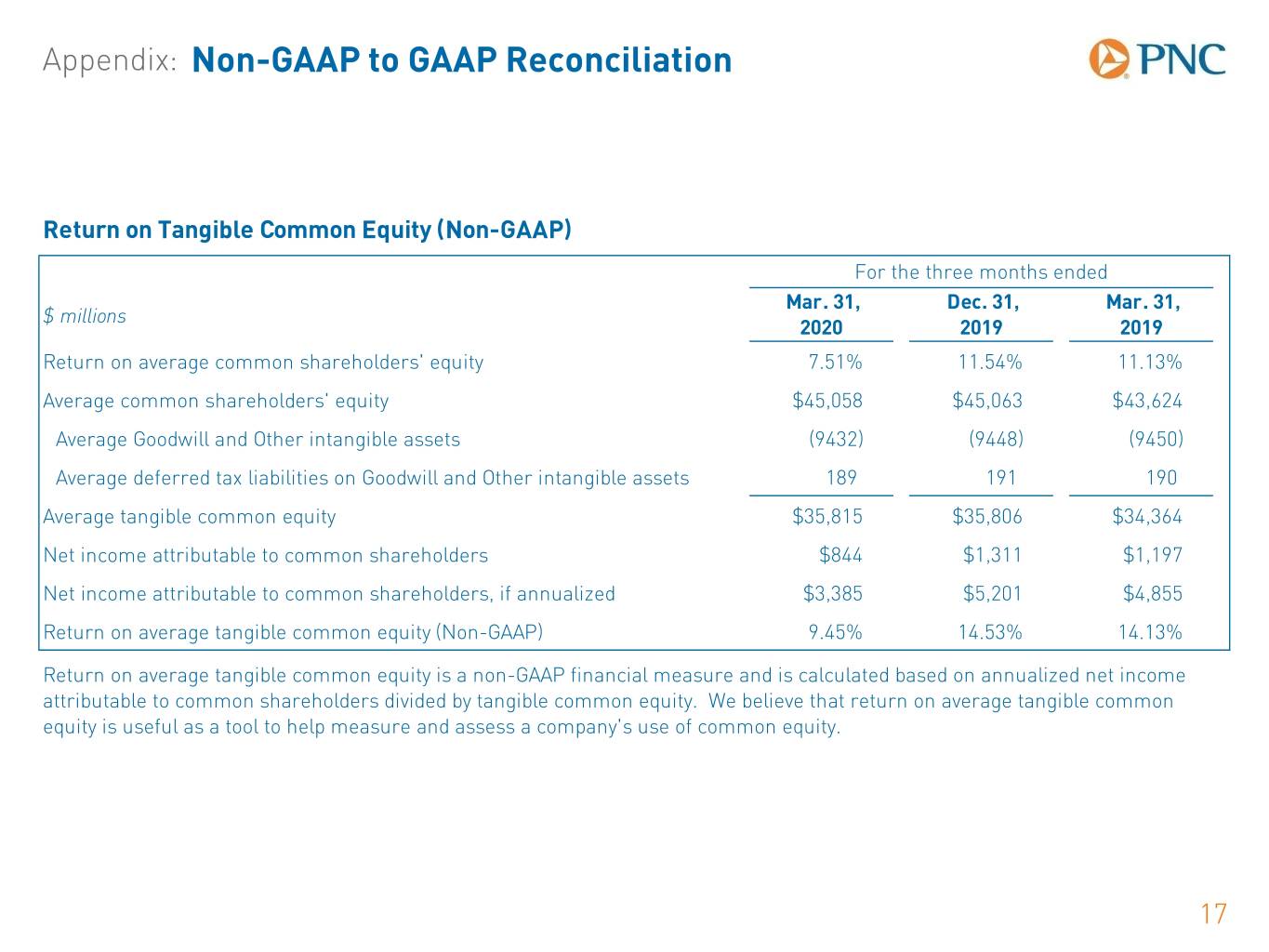
Appendix: Non-GAAP to GAAP Reconciliation Return on Tangible Common Equity (Non-GAAP) For the three months ended Mar. 31, Dec. 31, Mar. 31, $ millions 2020 2019 2019 Return on average common shareholders' equity 7.51% 11.54% 11.13% Average common shareholders' equity $45,058 $45,063 $43,624 Average Goodwill and Other intangible assets (9432) (9448) (9450) Average deferred tax liabilities on Goodwill and Other intangible assets 189 191 190 Average tangible common equity $35,815 $35,806 $34,364 Net income attributable to common shareholders $844 $1,311 $1,197 Net income attributable to common shareholders, if annualized $3,385 $5,201 $4,855 Return on average tangible common equity (Non-GAAP) 9.45% 14.53% 14.13% Return on average tangible common equity is a non-GAAP financial measure and is calculated based on annualized net income attributable to common shareholders divided by tangible common equity. We believe that return on average tangible common equity is useful as a tool to help measure and assess a company's use of common equity. 17
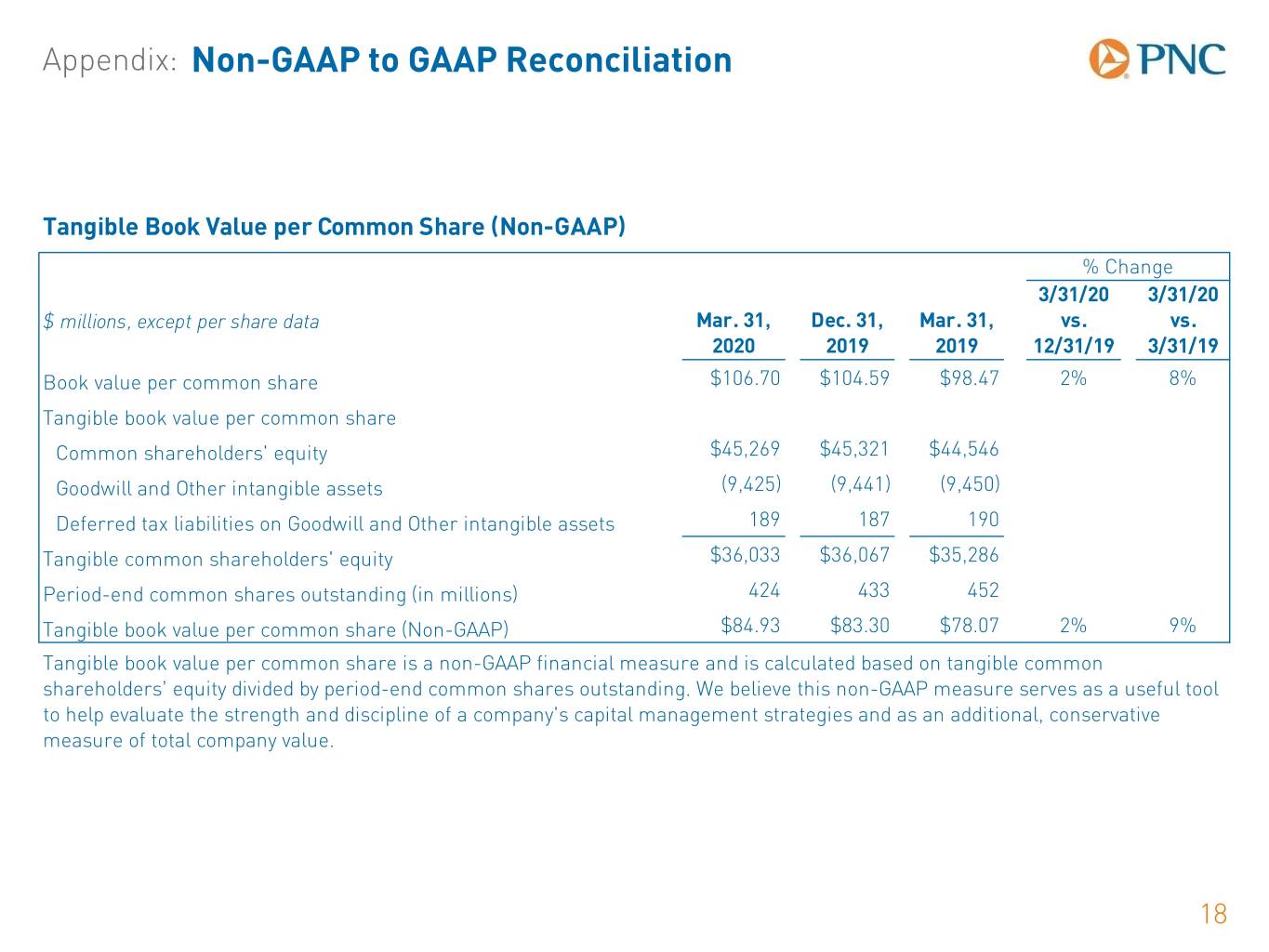
Appendix: Non-GAAP to GAAP Reconciliation Tangible Book Value per Common Share (Non-GAAP) % Change 3/31/20 3/31/20 $ millions, except per share data Mar. 31, Dec. 31, Mar. 31, vs. vs. 2020 2019 2019 12/31/19 3/31/19 Book value per common share $106.70 $104.59 $98.47 2% 8% Tangible book value per common share Common shareholders' equity $45,269 $45,321 $44,546 Goodwill and Other intangible assets (9,425) (9,441) (9,450) Deferred tax liabilities on Goodwill and Other intangible assets 189 187 190 Tangible common shareholders' equity $36,033 $36,067 $35,286 Period-end common shares outstanding (in millions) 424 433 452 Tangible book value per common share (Non-GAAP) $84.93 $83.30 $78.07 2% 9% Tangible book value per common share is a non-GAAP financial measure and is calculated based on tangible common shareholders’ equity divided by period-end common shares outstanding. We believe this non-GAAP measure serves as a useful tool to help evaluate the strength and discipline of a company's capital management strategies and as an additional, conservative measure of total company value. 18
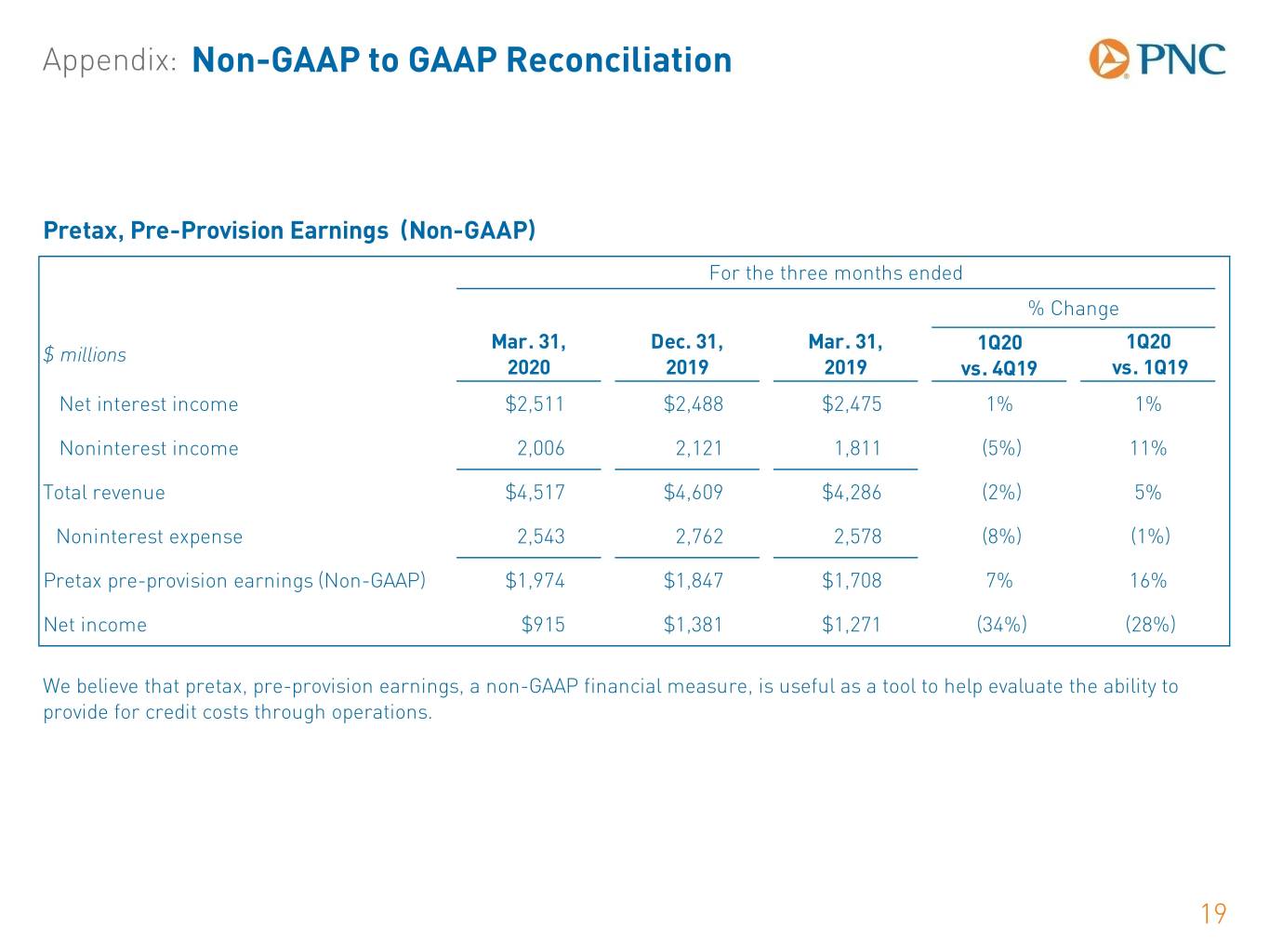
Appendix: Non-GAAP to GAAP Reconciliation Pretax, Pre-Provision Earnings (Non-GAAP) For the three months ended % Change Mar. 31, Dec. 31, Mar. 31, 1Q20 1Q20 $ millions 2020 2019 2019 vs. 4Q19 vs. 1Q19 Net interest income $2,511 $2,488 $2,475 1% 1% Noninterest income 2,006 2,121 1,811 (5%) 11% Total revenue $4,517 $4,609 $4,286 (2%) 5% Noninterest expense 2,543 2,762 2,578 (8%) (1%) Pretax pre-provision earnings (Non-GAAP) $1,974 $1,847 $1,708 7% 16% Net income $915 $1,381 $1,271 (34%) (28%) We believe that pretax, pre-provision earnings, a non-GAAP financial measure, is useful as a tool to help evaluate the ability to provide for credit costs through operations. 19